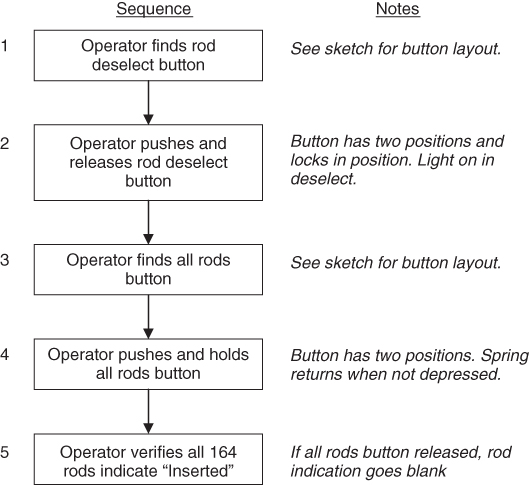10.2 Task Analysis
The task analysis breaks down the steps to be analyzed into its smallest set of actions. This breakdown must be very detailed. The task analysis may include steps that do not require human involvement. These additional steps are for continuity and will be eliminated during the HRA Modeling stage of the HRA (See Chapter 5 for more information on task analysis).
To perform the task analysis, information must be gathered on what actions are needed to complete the system to be analyzed. This information can come from procedures or other documentation that describes the system and the sequence to be analyzed (3).
Walk-throughs of the sequence with personnel familiar with the sequence are almost mandatory to ensure accuracy of the end result. Walk-throughs with more than one person will improve the credibility of the end result. Walk-throughs may also identify hidden problems (i.e., missing procedural steps, poorly designed instrumentation, poorly designed control layout, etc.) that may increase the probability of failure. Copious notes should be taken. Photographs or sketches of the instrumentation and control layout should also be obtained.
As part of the task analysis, the recovery from failure steps need to be identified. During the walk-through, the operations personnel should be asked what steps they would take to recover from a failure to perform a step or failure to perform a step properly.
The task analysis does not have a specified format; you can use whatever is comfortable and fits the situation. An example sequence and method for the task analysis is as follows.
This sequence should be done as many times as needed in order to thoroughly understand the actions and the factors affecting their performance.
We will use step 3, Verify Rods Inserted, from the SCRAM Actions sequence as an example task analysis as shown in Figure 10.1.
Figure 10.1 SCRAM actions for Verify Rods Inserted. The operations personnel should validate this sequence of steps and the sequence changed or notes added as needed.

10.2.1 Summary Points
- Task analysis breaks down the steps to be analyzed into its smallest set of actions.
- The task analysis needs to be very detailed and include recovery actions.
- The operators must validate the sequence.
